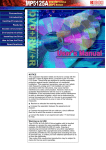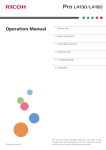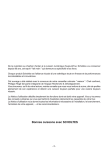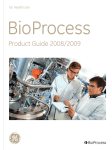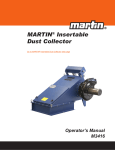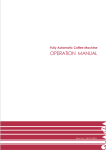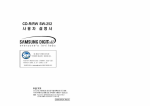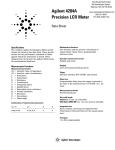Download Ricoh G410 Scanner User Manual
Transcript
Conventions Contents Introduction Conventions Handling Procedures Introduction Handling Procedures Features Features System environment System environment Drive functions and settings Drive functions and settings Installing the Drive Installing the Drive How to Use the Drive Specifications How to Use the Drive Specifications NOTICE This equipment has been tested and found to comply with the limits for a Class B digital device, pursuant to part 15 of the FCC Rules. These limits are designed to provide reasonable protection against harmful interference in a residential installation. This equipment generates, uses and can radiate radio frequency energy and, if not installed and used in accordance with the instructions, may cause harmful interference to radio communication. However, there is no guarantee that interference will not occur in a particular installlation. If this equipment does cause harmful interference to radio or television reception, which can be determined by turning the equipment off and on, the user is encouraged to try to correct the interference by one or more of the following measures: Reorient or relocate the receiving antenna. Increase the separation between the equipment and receiver. ● Connect the equipment into an outlet on a circuit different from that to which the receiver is connected. ● Consult the dealer or an experienced radio / TV technician for help. ● ● FCC WARNING Changes or modification not expressly approved by the party responsible for compliance could void the user's authority to operate the equipment. CAUTION Use of controls or adjustments or performance of procedures other than those specified herein may result in hazardous radiation exposure. Akustischer Geräuschpegel Use of controls or adjustments or performance of procedures other than those specified herein may result in hazardous radiation exposure. Dieser Druckerüberschreitet einen Geräuschpegel von 70 dB (A) während dem Betrieb nicht. Declaration of Conformity "The Product complies with the requirements of the EMC Directive 89/366/EEC and the Low Voltage Directive 73/23/EEC." ● ● ● ● ● ● ● Please take notice that the manufacturer of this equipment does not offer any warranty against data loss due to inappropriate installa-tion or handling, or direct or indirect damages. Please take notice that the manufacturer will bear no responsibility for direct or indirect damages caused by the use of this product or its malfunction. Please take notice that the manufacturer will bear no responsibility for damage to data caused by this product. Please backup (copy) all important data as protection against data loss. PC DOS is a trademark of IBM Inc. MS-DOS, Windows, and Windows ® 95 are trademarks registered in the United States and other countries by the Microsoft Corporation. The company names and product names written in this manual are trademarks or registered trademarks. Conventions This manual uses the following symbols which indicate important information. Be sure to read the information. Ignoring this warning and incorrect handling may result in serious personal injury or damage to the product. Indicates restriction or caution that you should notice. Provides useful additional information. << Contents Introduction This manual contains important notes and product handling information. Be sure to read the manual before using the product. For easy reference in the future, please keep the manual at a handy location. Multimedia Printer series Thank you for purchasing the Multimedia Printer series drive MP9060A (hereafter referred to as the drive). The drive enables you to play DVD-ROM or CD-ROM discs, write once and play CD-R discs, or write, play, and rewrite CD-RW discs. The following marks indicate media that can be used with the drive. <<Contents Handling Procedures Obey the following cautions when handling the drive or discs. Cautions During Installation ● Install the drive in accordance with the specifications. Be careful to avoid locations likely to cause vibration or shock. ● Avoid locations where there is high humidity, excessive dust, or poor ventilation. ● Avoid locations in direct sunlight, with severe changes in humidity, or places where there are extremely high or low temperature variations. ● Don't use the drive near radio or television receivers. It may interfere with their reception. Do not disassemble the drive. Dismantling the drive to attempt repairs or for other reasons is dangerous because the laser may radiate outside the unit. ● Cautions During Use Don't suddenly move the drive from a cold place to a warm place, or suddenly raise the room temperature. Condensation may occur, causing abnormal operation. ● ● Make sure to remove the disc before moving the drive. The disc may be damaged, causing data loss. Be careful to prevent foreign objects such as liquids or metal from entering the drive. Should by chance a foreign object enter the drive, please consult the dealer where the drive was purchased. ● Don't use benzene or thinner to clean dirt from the drive. Don't allow chemicals such as insecticides to contact the drive. Use a soft cloth to wipe the drive, or moisten a cloth with neutral detergent diluted with water and use it to clean particularly dirty areas. ● ● Don't cutoff the electric power while the drive is operating. When connecting two E-IDE devices to the Primary or Secondary connectors, make sure that the two devices are not both configured as Master, or both as Slave. If they are both set the same, Windows may fail to run or recognize the drives. ● ● The total length of the E-IDE cable should be less than 18 inches (about 45 cm). ● Make sure the power to the host computer is turned OFF before connecting. ● Never insert a damaged disc into the drive. In wintertime, don't use a disc soon after bringing in from outdoors. Use it only after it has reached room temperature. ● Cautions Concerning Disc Cleaning ● Remove the disc by pressing the eject button. ● Use compressed air to clear dust from the disc. (Spray the compressed air for about 5 seconds). ● Check to see if there is dirt on the surface of the disc. Be careful not to touch the disc with the fingers when doing this. (See Fig. 1) ● After cleaning the disc with compressed air, place it on the disc tray and mount it.(See Fig. 2) ● We suggest using Perfect Duster II (80z.) as compressed air for cleaning. Other Cautions ● When moving the equipment, make sure that the disc has been removed from the drive. When connecting connectors, make sure that the power is OFF. If the power is ON, there is a possibility of short circuit. ● When not using the drive for a long period, dust may adhere to the disc tray. Before using the drive again, use dry air cleaner to remove the dust from the tray. ● << Contents fig1 1. Check 2. Recording surface fig2 1. 50 to 100mm Back << Contents Features ● ● ● ● ● ● ● ● ● Completely sealed door construction provides high reliability. An improved anti-heat design means that no cooling fan is needed. Easy-to-use tray model. Enhanced-IDE (ATAPI) model Compliant with industry standard Orange Book Part II (CD-R) and Part III (CD-RW). Can read not only DVD-ROM, CD-R and CD-RW discs, but also video CDs, music CDs, photo CDs, and CD-Text Can read data at 24x speed*1 (3.6MB/sec data transfer rate) and write data at 6x speed *2(900KB/sec data transfer rate). The recorded CD-RW media can be played in a DVD player or a multi-read CD-ROM Player, maintaining future compatibility. Supports random UDF for easy writing to CD-RW discs. *1 The playback speed of DVD-ROM discs is 4X (data transfer rate is 5.54MB/second(MAX). *2 Can write to CD-RW discs at 4X speed (600 KB/second data transfer rate). << Contents System environment Explains the system environment required for using the drive as a CD-R/CD-RW drive. PC Operating System IBM PC/AT compatible Windows 98/95 Windows NT Workstation Ver.4.0 (Service Pack 3) or later CPU 166MHz (or faster) Pentium Memory Windows 98/95 : 32MB or greater. Windows NT Workstation Ver.4.0 : 32MB or greater (64MB or more recommended) Harddisk Hard disk with average access time of 19msec or less, and data transfer speed of 1,200KB/sec or greater. 75MB or more free space.(The free space needed for writing depends on the quantity of data.)*1 Interface Enhanced-IDE interface (as Primary Slave, Secondary Master, or Slave) Drive bay 5.25-inch half height bay required Power +5V/+12V power socket required CD-R, CD-RW discs Ricoh, Mitsubishi Chemical, Taiyo Yuden, Mitsui Chemicals, Ritek, CMC, Princo, TDK, Kodak, Memorex, Maxcell or Fhilips discs are recommended.*2 *1 Average access time of 12msec or less and data transfer speed of 5MB/sec or greater are recommended. *2 The disc written using the CD-R/RW drive may not be readable by CD-ROM drives. Multi-read compatible (Random UDF compatible) drives are necessary. Multi-read compatible (Random UDF compatible) drives are: ● ● <<Contents Drives that can read low reflectivity discs. Drives that support Packet Write. Specifications Drive | Disc Drive : MP9060A Type Internal type (bare drive) Interface Enhanced-IDE (ATAPI) Data buffer memory 2MB Data transfer speed 16.6MB/sec. (Max.) CD-R/CD-RW Write/Read speed (Ave.) 24X: 20X: 20X: 8X: 8X: 6X: 6X: 4X: 4X: 2X: 2X: 1X: 1X: 3.60 MB/sec. (Mode1, Mode2, Form1)[Read only]*1 3.00 MB/sec. (Mode1, Mode2, Form1)[Read only] 3.40 MB/sec. (Mode2, Form2)[Read only] 1,200 KB/sec. (Mode1, Mode2, Form1)[Read only] 1,362 KB/sec. (Mode2, Form2) [Read only] 900 KB/sec. (Mode1, Mode2, Form1) 1,021 KB/sec. (Mode2, Form2) 600 KB/sec. (Mode1, Mode2, Form1) 681 KB/sec. (Mode2, Form2) 300 KB/sec. (Mode1, Mode2, Form1) 340 KB/sec. (Mode2, Form2) 150 KB/sec. (Mode1, Mode2, Form1) 170 KB/sec. (Mode2, From2) DVD-ROM Read speed 4X: 5.5 MB/sec. (MAX.) Average access time 120msec. or less (DVD 200msec. or less) Initial processing time CD-ROM 14sec. or less CD-R/RW 19sec. or less DVD-ROM 19sec. or less Mounting direction horizontal/vertical Compatible formats Format CD-DA CD-ROM CD-Extra CD-ROM XA Photo CD*3 CD-i*3 CD-ROM + CD-DA Video-CD CD-Text Write Read Play*2 * * * * * * * * * * * * * * * * * * * Loading system Tray type (automatic loading/eject) Power DC5V, DC12V Power consumption 12w max. (normal operation) 6w max. (standby) * * * * Weight Less than 1.5 Kg. Dimensions 148.4 X 198(included front panel) X 42.5mm Reliability Error Rate: MTBF: MTTR: 10-12 bits or less 100,000hours or greater Within 30 minutes Environmental Conditions Temperature Humidity Vibration Shock Environmental dust When operating When not operating 5°C to 40°C (No air cooling) -30°C to 65°C 55% to 90% R.H. 5% to 95% R.H. (No condensation) (No condensation) 0.035mmpp(10 to 45Hz) 1 X 9.8 m/s2 0.025mmpp(45 to 65Hz) (5 to 300Hz) 0.2 X 9.8 m/s2 (65 to 150Hz) 2 2 X 9.8 m/s 40 X 9.8 m/s2 (11msec. half sine) (6msec. half sine) Class 3 million or less (3 million particles of 0.5 micron dustper cubic foot or less) *1 Speed is automatically reduced if reading is unsuccessful. *2 "Play" means playback. Also, "Read" means transferring data. *3 CD-i and Photo-CD discs require special reader/player. Also, Photo-CD requires a license from Kodak. The drive's appearance and specifications may change without notice. Disc Characteristic External diameter Dimensions Internal diameter Thickness Recording area (User area) Recording capacity CD-R CD-RW CD-R CD-RW ø120mm ø120mm ø15mm ø15mm 1.2mm 1.2mm ø50 to 116mm ø50 to 116mm Time 80min.*1 74min. 63min. 74min. Capacity 700MB 650MB 550MB 650MB Linear speed 1.2m/s 1.2m/s 1.4m/s 1.2m/s Track pitch 1.6 ± 0.1µm 1.6 ± 0.1µm Substrate material Polycarbonate Polycarbonate Recording material Organic pigment (phthalocya-nine) / Au or Ag lamination (Organic protective layer attached) Ag-In-Sb-Te phase change recording material Reflectance (R to p) 65% or more 15 to 20% Eccentricity 70µm or less 70µm or less Maximum camber angle Recommended recording power Playback power Playback stability Environment for use Storage life 0.4° or less 0.4° or less 6 to 7mW(at ƒÉ:785nm, NA:0.5) 8 to 14mW(at ƒÉ:785nm, NA:0.5) 1mW or less 1mW or less 106times or more (Playback power = 0.7mW) -5 to 55°C 106times or more (Playback power = 1mW) 10 to 40°C 5 to 95%RH 100 years or more 5 to 25°C, 5 to 60%RH Avoiding direct sunlight) 10 to 80%RH Number of rewrites -----------* The above specifications are for Ricoh CD-R and CD-RW discs * Recommended Discs 30 years or more 5 to 25°, 5 to 60%RH 1,000 times or more CD-R (74min./63min.) : Ricoh, Taiyo Yuden, Mitsubishi Chemical, Mitsui Chemicals, Ritek, CMC, Princo, TDK, Kodak, Memorex, Philips, and Maxell discs Taiyo Yuden, TDK, Maxell, Philips CD-R (80min.)*1 : CD-RW : Rioch, Mitsubishi Chemical, Memorex CD-RW (80min.) : Philips For the latest disc information, please refer to Ricoh's website. << Contents Drive functions and settings Front Panel | Rear panel Front Panel 1. Disc tray This is the tray for the disc. Place the disc on the ejected disc tray, then lightly push the tray (or push the eject button) and the disc will be mounted. Caution Don't use force to pull out or push in the disc tray. This might cause damage to the loading section of the drive. 2. Headphone jack This jack is for connecting headphones or mini-speakers. 3. Volume control This is used to adjust the output volume of the headphone jack. It can't be used to adjust the output volume for the audio output connectors on the rear panel. Caution Turn the volume down before turning on the power. Sudden loud noises can damage your hearing. 4. Busy indicator This indicator lights orange when a disc is mounted into the drive. When the disc is being accessed, it flashes or lights orange. If a disc is not mounted, the indicator does not light even when the power is turned on. When a illegal disc is loaded or some hardware trouble occurs, the indicator blinks. 5. Eject button This is the button used to eject or insert in the disc tray. 6. Emergency eject hole This drive has a function that allows the disc to be ejected manually if this becomes necessary in an emergency such as failure of the drive or a power outage. Caution This feature is a last measure to be used only in an emergency. Using it excessively will cause malfunction. Rear panel 1. Digital Audio Output Connector Provides output to a sound card (Digital signal). 2. Analog Audio Output Connector Provides output to a sound card (Analog signal). 3. Jumper Connector This jumper determines whether the drive is configured as a master or slave. Changing the master-slave configuration takes effect after power-on reset. 4. IDE Interface Connector Connect to the IDE (Integrated Device Electronics) interface using a 40-pin flat IDE cable. Caution Do not connect or disconnect the cable when the power is on, as this could cause a short circuit and damage the system. Always turn the power OFF when connecting or disconnecting the cable. 5. Power Connector Connects to the power supply (5 and 12V DC) of the host computer. Caution Be careful to connect with the proper way. Connecting the wrong way may damage the system (and is not guaranteed). << Contents Emergency Eject This drive has a function that allows the CD to be ejected manually, if this becomes necessary in an emergency such as failure of the drive or a power outage. Follow the following procedures in such a case. Caution This feature is a last measure to be used only in an emergency. Using it excessively will cause malfunction. 1. Turn the power to OFF. 2. Insert a fine tipped object into the emergency eject hole. The front door pops open and the disk tray comes partway out. 3. Pull the front door to open it all the way, then grip the disc tray between thumb and forefinger and gently pull it straight out. Note If you cannot get a good grip on the disc tray with your fingers, use a steel binder clip or spring clamp to pull it out. Back Next Load the disc | Disc ejection | Emergency Eject Using the Drive in a Vertical Position << Contents Disc ejection 1. Press the eject button 2. Slowly take the disc out of the disc tray 3. Press the eject button or push the disc tray and the tray will be inserted back into the drive. Caution After ejecting the disc, return the disc tray inside the unit quickly. When the disc tray is in the ejected position, dust and other debris will enter, possibly causing read errors, write errors, or drive failure. Back Next Load the disc |Disc ejection | Emergency Eject Using the Drive in a Vertical Position << Contents Load the disc 1. Press the eject button. 2. Place the disc on the disc tray. Be careful not to touch the recording surface of the disc. 3. Load the disc by pressing the eject button or by lightly pushing in the disc tray. Next Load the disc | Disc ejection | Emergency Eject Using the Drive in a Vertical Position << Contents Using the Drive in a Vertical Position The drive can be installed in a vertical position. 1. Locate the four tabs on the disc tray. Turn each of them inwards untill they click into place. 2. When loading a disc, insert it into the inner side of the tabs. Back Load the disc | Disc ejection | Emergency Eject Using the Drive in a Vertical Position << Contents Installing the Drive Specific knowledge of hardware and software is necessary to install the drive. We cannot guarantee against direct or indirect damage resulting from improper connections. Ask your supplier for details of the installation procedure. Before Installation Before installing the drive, please note the following points. ● You will need the following: ❍ A Phillips head screw driver of a suitable size to fit the securing screws for the drive unit. ❍ The manual for the computer, to know the location of the IDE connector. ● Turn off all peripheral appliances of the computer, and the computer itself, and disconnect their power cords from the wall sockets. ● Discharge any static electricity by touching the computer covers etc. ● Before installing the drive, be sure to read the following cautions and information on preparation. Keep a serial number label at the location specified by "READ ME FIRST". Installing the Drive 1. Jumper Set Up 2. Removing the Computer Cover 3. Mounting the Drive 4. Connecting the Power Connector 5. PC Connections 6. Sound Card Connection 7. Replacing the Computer Cover 8. Device Drivers << Contents 1. Jumper Set Up Before installation, set the jumper on the jumper connector on the rear panel. 1. Master (MA) Drive set as Master (factory default) 2. Slave (SL) Drive set as Slave 3. Cable Select (CS) Drive mode set by CSEL on the host IDE interface Note ❍ ❍ ❍ The drive can be connected as the Master or Slave on an E-IDE (ATAPI) interface. When several (up to four) E-IDE devices are connected, each must be set in a unique way. A hard disk is normally installed as the Primary Master on the E-IDE (ATAPI) interface. Other E-IDE peripheral devices such as hard drives and CD-ROMs are then set accordingly. Caution ● ● ● If two peripheral devices with the same settings are both connected to the Primary or to the Secondary E-IDE bus, the host computer may fail to run, or may malfunction, so careful attention is necessary. Make sure that the host computer is turned OFF when connecting or removing a jumper. Must be connect the jumper in the vertical direction. If connected horizontally, the drive may malfunction or be damaged. ● Only one jumper should be installed on the jumper connector. If more than one jumper is installed, the drive may malfunction or be damaged. Next 1. Jumper Set Up | 2. Removing the Computer Cover 3. Mounting the Drive | 4. Connecting the Power Connector 5. PC Connections | 6. Sound Card Connection 7. Replacing the Computer Cover | 8. Device Drivers << Contents 2. Removing the Computer Cover Make sure all peripheral devices of the computer and the computer itself are turned off, and then remove the cover. Refer to the manual for the computer for details about removing the cover. Caution There may be sharp edges inside the computer take care to avoid injury. Back Next 1. Jumper Set Up | 2. Removing the Computer Cover 3. Mounting the Drive | 4. Connecting the Power Connector 5. PC Connections | 6. Sound Card Connection 7. Replacing the Computer Cover | 8. Device Drivers << Contents 3. Mounting the Drive 1. Remove the 5 inch drive bay panel from the computer. Refer to the manual for the computer for details. 2. Insert the drive unit into the bay. Do not apply excessive pressure to the cables inside the computer. 3. Secure the drive with the screws provided. If there is not enough space behind the drive, connect the E-IDE cables etc. before securing the drive. Back Next 1. Jumper Set Up | 2. Removing the Computer Cover 3. Mounting the Drive | 4. Connecting the Power Connector 5. PC Connections | 6. Sound Card Connection 7. Replacing the Computer Cover | 8. Device Drivers << Contents 4. Connecting the Power Connector Connect the power cable from the computer's power supply to the socket on the drive unit, fitting the connector properly into the socket. If there is no spare power cable available in the computer, you will have to purchase a splitter cable of a suitable type. Back Next 1. Jumper Set Up | 2. Removing the Computer Cover 3. Mounting the Drive | 4. Connecting the Power Connector 5. PC Connections | 6. Sound Card Connection 7. Replacing the Computer Cover | 8. Device Drivers << Contents 5. PC Connections The drive connects to the motherboard of the host computer using an IDE interface cable. Both Primary and Secondary connectors are usually provided on the motherboard, which may be connected as follows: 1. Master 2. Slave 3. Motherboard 4. Primary 5. Secondary 6. less than 6 inches 7. less than 18 inches To Install as a Master Drive To Install as a Slave Drive To Install as a Master Drive To install the drive as a Master, the jumper can be left as supplied from the factory. 1. Master drive (MP9060A) 2. Master drive (Booting hard disk) 3. Secondary connector 4. Primary connector 5. Slave drive (Other IDE drive) To Install as a Slave Drive To install the drive as a Slave, change the jumper setting on the rear panel. 1. Master drive (Booting hard disk) 2. Slave drive (MP9060A) 3. Secondary connector 4. Primary connector 5. Slave drive (Other IDE drive) Back Next 1. Jumper Set Up | 2. Removing the Computer Cover 3. Mounting the Drive | 4. Connecting the Power Connector 5. PC Connections | 6. Sound Card Connection 7. Replacing the Computer Cover | 8. Device Drivers << Contents 6. Sound Card Connection If the computer has a sound card, the drive can be connected to the sound card with an audio cable. Make sure the connections are oriented so that L corresponds to L and R to R. Refer to the manual for the sound card for detailed infor-mation regarding connection. Audio digital output The drive supports S/PDIF(IEC958) for digital audio output. As long as the sound board comes with S/PDIF input, it can be connected externally to the D/A converter. The drive can be used as a CD transporter for playing CDs at the desired sound quality level. 1. 2. 3. 4. 5. MP9060A When L,R Sound Card Motherboard Primary or Secondary Back Next 1. Jumper Set Up | 2. Removing the Computer Cover 3. Mounting the Drive | 4. Connecting the Power Connector 5. PC Connections | 6. Sound Card Connection 7. Replacing the Computer Cover | 8. Device Drivers << Contents 7. Replacing the Computer Cover When the installation of the drive unit is complete, replace the computer cover. Back Next 1. Jumper Set Up | 2. Removing the Computer Cover 3. Mounting the Drive | 4. Connecting the Power Connector 5. PC Connections | 6. Sound Card Connection 7. Replacing the Computer Cover | 8. Device Drivers << Contents 8. Device Drivers When using Windows 98/95 or Window NT Workstation Ver. 4.0, the installation of any special device drivers are not required. In order to ensure normal drive operation or if the drive is not recognized by your computer, please check the following: In order to ensure normal drive operation If the drive is not recognized by your computer In order to ensure normal drive operation please check the following For Windows 98/95 Users ● ● The drive is displayed in [control panels] - [system] - [device manager] - [CD-ROM] 32-bit is displayed in [control panels] - [system] - [performance] For Windows NT Workstation Ver.4.0 Users ● The drive is displayed on the IDE controller in [control panels] - [SCSI adapter] -[devices] If the drive is not recognized by your computer For Windows 98/95 Users ● If a [!] indicator is displayed on the IDE controller in [control panels] - [system] -[devices manager]-[harddisk controler], you will need to contact your PC manufacturer or the motherboard manufac-turer and get the appropriate IDE controller driver. For Windows NT Workstation Ver.4.0 Users ● If a [!] indicator is displayed on the IDE controller in [control panels] - [SCSI adapter] -[devices] , you will need to contact your PC manufacturer or the motherboard manufacturer and get the appropriate E-IDE controller driver. Back 1. Jumper Set Up | 2. Removing the Computer Cover 3. Mounting the Drive | 4. Connecting the Power Connector 5. PC Connections | 6. Sound Card Connection 7. Replacing the Computer Cover | 8. Device Drivers << Contents How to Use the Drive Caution When using CD-ROM discs, DVD-ROM discs, CD-R discs or CD-RW discs, do not attach any stickers or labels to the discs. Using discs with labels attached not only causes read and write errors, but data on the disc may be lost due to dam-age to the disc itself. ● Load the disc ● Disc ejection ● Emergency Eject ● Using the Drive in a Vertical Position << Contents * All references to the product in this document are to specifications in effect when the product was released. Copyright RICOH Co.Ltd. All rights reserved.








































